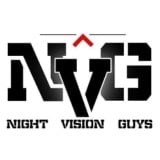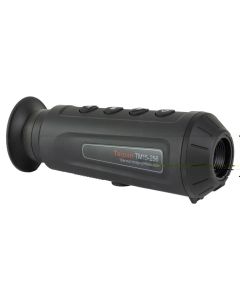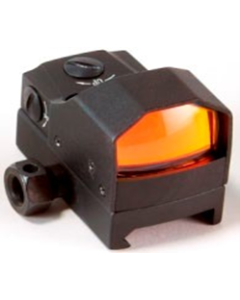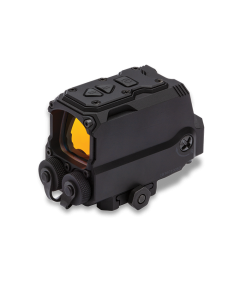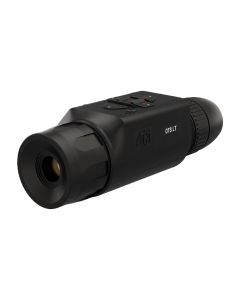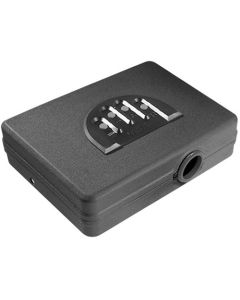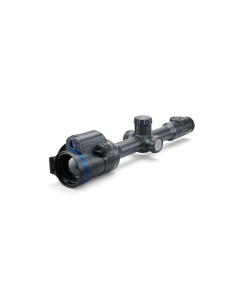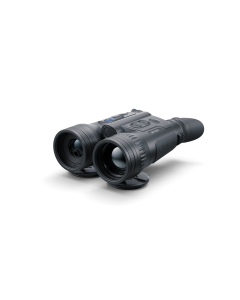Pulsar Helion XQ38F Thermal Monocular 3-12X38
From Pulsar about Quantum LD19S Thermal Imaging Monocular
See what you’ve been missing at more than 500 yards away with the LD19S. This high definition thermal device delivers “white hot” and “black hot” heat signature observation that can be used for commercial purposes such as detecting leaks, poor ventilation or hot spots of homes and buildings. The 9 hertz frame rate contributes to a smoother, more consistent image of faster-moving objects at long distances. Its 3 new brightness modes (City, Forest and Identification) offer enhanced contrast, significantly improving rendering of hot object details. Operators can choose from the automatic, manual or semi-automatic calibration modes, which calibrates the lens in just 1 to 2 seconds. The longer-distance viewing is made possible by the 2x digital zoom, which increases the 1.1x magnification to 2.2x for a wider field-of-view, and high definition OLED display—the clearest display resolution available on the market.
From the market about Quantum LD19S Thermal Imaging Monocular
With a quick start-up time, the Pulsar Quantum 19S Thermal Imaging Scope also delivers on best possible images in specific viewing conditions. This thermal imager by the specialists at Pulsar features a body of fiberglass and reinforced plastic that is able to effectively withstand impact, moisture and dust which allows the units to be used in extreme conditions. The Pulsar Quantum 19S Thermal Monocular has a wide range of operating temperatures with brightness and contrast control. The Pulsar Quantum 19S Thermal Imaging Monocular w/ Frost-resistant OLED Display is your answer for effective night hunting.
| Electronic components | |
| Frame Rate, Hz | 9 |
| Microbolometer resolution, pixels | 384x288 |
| Sensor response | LWIR |
| Spectral Sencitivity, µm | 7.7 to 13.2 |
| Pixel Pitch, µm | 25 |
| Display type | OLED display |
| Display Resolution, pix. | 640x480 |
| Display diagonal, inch | 0.31 |
| Video output | PAL/ NTSC |
| Pin type of video input / output | 3.5mm jack |
| Operation modes | city, forest, identification |
| Defective pixel repair option, yes/no | yes |
| Optical characteristics | |
| Magnification | 1.1 |
| Digital zoom, x | 2 |
| Lens diameter, mm | 16 |
| Lens focus, mm | 19 |
| Relative aperture, D/f' | 1:1.2 |
| Field of View,°, horizontal * vertical | 26.8x20.8 |
| Field of View, m@100m, horizontal* vertical |
50.5x38 |
| Minimum focusing distance, m | 3 |
| Eye Relief, mm | 20 |
| Exit Pupil, mm | 8 |
| Diopter adjustment, dptr. | ±5 |
| Focusing type of distance | internal |
| Range of Detection, m | |
| Range of detection, m /yd(object (high*width = 1,7*0,5m) |
500 / 547 |
| Power Supply | |
| Power Supply, V | 4 ÷ 6 |
| Battery type | 4xAA |
| Battery life, hour | 4.5 ... 5.5 |
| External Power Supply | DC 8.4 ÷ 15 |
| Physical & operational characteristics | |
| Lens Material | germanium |
| Body Material | glass-nylon composite |
| Tripod Mount, inch | 2x 1/4 |
| Type of mount for additional accessories |
weaver |
| Operating Temperature,°C / °F | - 20 to 50 / -4 to 122 |
| Degree of Protection (acc. to IEC 60529) |
IPX4 |
| Calibration | manual automatic semi-automatic |
| Length, mm | 180 |
| Width, mm | 86 |
| Height, mm | 58 |
| Weight (without batteries), oz | 11.3 |
Pulsar Quantum LD19S Monocular Box Contents
Carrying case
Output Video cable
Hand strap
Car adapter
Extra battery container
Lens Cleaning cloth
Quantum LD19S Monocular Key Features
- 384x288 microbolometer resolution • 9hz refresh rate
- 1.1 - 2.2x magnification (Due to 2x digital zoom)
- 640x480 display resolution
- Manual, automatic, and semi automatic calibration modes
- City, forest, and identification viewing modes
- Hot white/ hot black viewing modes
- Up to 550 yd detection range (human size target) • Long viewing range
- OLED display
- Brightness and contrast adjustments
- Video output
- Quick start-up
- External power supply adaptable
- Compact and light weight
Thermal Imaging
Please note that most thermal devices are built per order. It may take 3-5 days or more for your order to ship. If timely shipping is important to you, please, contact us to verify availability prior to ordering.
Thermal devices can produce various types of images. Some are color others are monochrome. In either case change in shade or color indicates temperature differences.
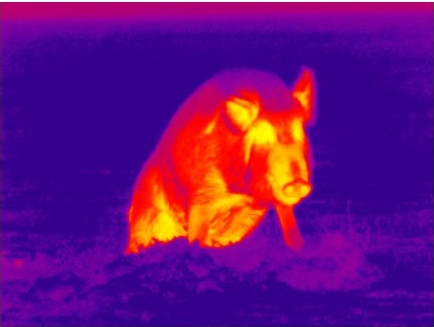

Here is how thermal imaging devices work...
A special lens focuses the infrared light emitted by all of the objects in view.
The focused light is scanned by a phased array of infrared-detector elements. The detector elements create a very detailed temperature pattern called a thermogram. It only takes about one-thirtieth of a second for the detector array to obtain the temperature information to make the thermogram. This information is obtained from several thousand points in the field of view of the detector array.
The thermogram created by the detector elements is translated into electric impulses.
The impulses are sent to a signal-processing unit, a circuit board with a dedicated chip that translates the information from the elements into data for the display.
The signal-processing unit sends the information to the display, where it appears as various colors depending on the intensity of the infrared emission. The combination of all the impulses from all of the elements creates the image.
There are a few key Manufacturers when it comes to thermal imaging.
ATN: produce such well knows devies as ThOR-HD thermal scope, BINOX-THD thermal binoculars, and OTS-HD thermal monocular.
FLIR/Armasight: the largest maker of consumer level thermal products is well knows for their full product line. Zeus thermal scopes, Q14 and Scout monoculars, Helios and Scout binoculars and many more.
Pulsar: a very popular brand for digital night vision and thermal imaging. Key products include Pulsar Trail and Apex thermal scopes and Pulsar Helion and Quantum thermal monoculars.
Seek: mobile device mounted thermal cameras are the main products of this brand.
Delivery Time and Manufacturing Process for Pulsar Quantum LD19S Thermal Monocular:
Most of our manufacturers do not keep products like Pulsar Quantum LD19S Thermal Monocular assembled on the shelf. Night Vision tubes are kept separate from the body of the unit. When the order is placed, the manufacturer starts the order processing and assembly process which includes the following:
- Order processing - we collect all the necessary information including address and phone numbers. We also make sure that our customer ordered the correct product for their needs and that the product can be exported by US law to the country of destination. In some cases a signed export compliance form is required.
- QC - in this step the manufacturer will inspect all individual parts which will be used to assemble the night vision device for any defects.
- Production & Assembly - during production, all the parts are put together. Night Vision tubes in inserted into the body of the unit and all the complex electronics for the device are connected. This process takes place in a special lab called the "clean room" as even a small speckle of dust can cause undesired optical effect.
- QA - one the night vision device is assembled, it goes through a rigorous testing process to make sure it meets all the expected specifications and all parts function as expected. For this most manufacturers have a special "dark room" designed to allow testing of the units without causing incidental damage to the night vision tube by exposure to bright light.
- Packaging - this is a key process as well. In most case your night vision device will be shipped to you directly from the manufacturer but sometimes needs to be sent to us first. In either case items need to be packaged securely to avoid any kind of damage during transportation.
- Shipping - as described above items will most of the time ship from the manufacturer. For most domestic orders (unless shipping to POB or AFB) a premium shipper like FedEx or UPS will be used.
Only by following the above steps can we along with our manufacturers bring you - our customer - night vision products of highest quality, However as you can understand the above process can take several days to complete. For example if your device fails QA, the entire process restarts. Also at QC stage a manufacturer may realize that the tube they have in stock has a defect and a replacement tube needs to be ordered. Due to the complexity of this process, it is prudent to expect 3-4 business days for production and handling of the purchased device. Keep in mind that this process is designed to guarantee your satisfaction with the night vision device of your choice. It occasionally possible to expedite the process for urgent orders but addional fees or other restrictions may apply.










